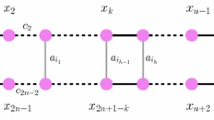Abstract
We consider the Peierls model for closed polyactetylene chains with an even number of carbon atoms as well as infinite chains, in the presence of temperature. We prove the existence of a critical temperature below which the chain is dimerized and above which it is 1-periodic. The chain behaves like an insulator below the critical temperature and like a metal above it. We characterize the critical temperature in the thermodynamic limit model and prove that it is exponentially small in the rigidity of the chain. We study the phase transition around this critical temperature.

Similar content being viewed by others
References
Bach, V., Lieb, E.H., Solovej, J.P.: Generalized Hartree-Fock theory and the Hubbard model. J. Stat. Phys. 76(1), 3–89 (1994)
Fröhlich, H.: On the theory of superconductivity: the one-dimensional case. Proc. R. Soc. Lond. Ser. A. Math. Phys. Sci. 223(1154), 296–305 (1954)
Garcia Arroyo, M., Séré, E.: Existence of kink solutions in a discrete model of the polyacetylene molecule. Preprint hal-00769075 (2012)
Jones, H.: Applications of the Bloch theory to the study of alloys and of the properties of bismuth. Proc. R. Soc. Lond. Ser. A-Math. Phys. Sci. 147(861), 396–417 (1934)
Kennedy, T., Lieb, E.H.: Proof of the Peierls instability in one dimension. In: Condensed Matter Physics and Exactly Soluble Models, pp. 85–88. Springer (2004)
Kivelson, S., Heim, D.: Hubbard versus Peierls and the Su-Schrieffer-Heeger model of polyacetylene. Phys. Rev. B 26(8), 4278 (1982)
Lieb, E.H., Nachtergaele, B.: Stability of the Peierls instability for ring-shaped molecules. Phys. Rev. B 51(8), 4777 (1995)
Lieb, E.H., Schultz, T., Mattis, D.: Two soluble models of an antiferromagnetic chain. Ann. Phys 16(3), 407–466 (1961)
Macris, N., Nachtergaele, B.: On the flux phase conjecture at half-filling: an improved proof. J. Stat. Phys. 85(5–6), 745–761 (1996)
Peierls, R.E.: Quantum Theory of Solids. Clarendon Press (1996)
Pouget, J.P., Kagoshima, S., Schlenker, C., Marcus, J.: Evidence for a Peierls transition in the blue bronzes K0. 30MoO 3 and Rb0. 30MoO3. J. de Phys. Lettres 44(3), 113–120 (1983)
Su, W.P., Schrieffer, J.R., Heeger, A.: Solitons in polyacetylene. Phys. Rev. Lett. 42(25), 1698 (1979)
Author information
Authors and Affiliations
Corresponding author
Additional information
Communicated by Vieri Mastropietro.
Publisher's Note
Springer Nature remains neutral with regard to jurisdictional claims in published maps and institutional affiliations.
Appendix A: Gain of Energy in the Thermodynamic Limit
Appendix A: Gain of Energy in the Thermodynamic Limit
In this section, we prove that the gain of energy due to Peierls dimerization is exponentially small in \(\mu \). We focus on the thermodynamic limit case (although the proof is similar in the \(L \in 2 \mathbb {N}\) case). We also focus only on the null temperature case \(\theta = 0\). In this case, the thermodynamic energy reads
We introduce
In other words, \(f_0\) is the minimum of \(g_0\) over 2–periodic (and all) configurations, and \(f_{0, \textrm{per}}\) is the minimum over 1-periodic configurations. We prove the following
Theorem A.1
There is \(C > 0\) such that, for all \(\mu \) large enough,
In other words, the energy gained by the Peierls distorsion is exponentially small in the \(\mu \) parameter. The first inequality states that in the thermodynamic limit at null temperature, the minimizers are always dimerized, as first proved by Kennedy and Lieb [5].
Proof
Let us first compute \(W_1\), the optimizer of \(g_0(W, 0)\). This is simply the minimum of
The minimizer satisfies \(\mu (W_1 - 1) = \frac{4}{\pi }\), hence \(W_1 = 1 + \frac{4}{\pi \mu }\). In particular,
We now compute the energy gain from the breaking of periodicity. For \((W, \delta )\) a trial pair, we write \(W = W_1 + \varepsilon .\) We assume that \(g_0(W,\delta )< g_0(W_1,0). { \mathrm Then} \)
To compute the integral, we make the change of variable \(u=\cos (s),\) and get that the integral equals
Using that
where E is a complete elliptic integral of the second kind, we get
We now minimize the right-hand side. For large \(\mu \), we have \(W_1 \approx 1\) and the minimization in \(\varepsilon \) gives \(\varepsilon = 0\). So
We optimize the right-hand side by taking \(\delta = {\textrm{e}}^{-(\frac{\pi }{4}\mu + \frac{1}{2})} \), and this completes the proof. \(\square \)
Rights and permissions
Springer Nature or its licensor (e.g. a society or other partner) holds exclusive rights to this article under a publishing agreement with the author(s) or other rightsholder(s); author self-archiving of the accepted manuscript version of this article is solely governed by the terms of such publishing agreement and applicable law.
About this article
Cite this article
Gontier, D., Kouande, A.E.K. & Séré, É. Phase Transition in the Peierls Model for Polyacetylene. Ann. Henri Poincaré 24, 3945–3966 (2023). https://doi.org/10.1007/s00023-023-01299-w
Received:
Accepted:
Published:
Issue Date:
DOI: https://doi.org/10.1007/s00023-023-01299-w



